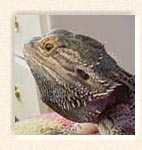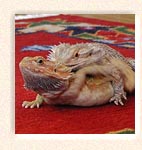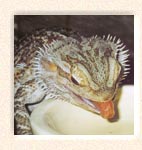|
Bearded Dragon behaviors
To take good care of your dragon you have to know its behavior. If you don't - it is difficult to give them the best possible care. There are certain behaviors that more or less all dragons do. But it is important that you spend time watching your lizard and see how it acts in different situations. All dragons are individuals and they all behave different. If you learn your dragons' behavior you know when it is scared, in pain or acting in a strange way.
We humans often read in human reactions and values in the behavior of our lizards. But what you think you see - isn't always what you think. Try to be objective and remember that your dragon is a reptile - not a human being. A certain behavior isn't always what it seems to be.
Arm waving
This is a submissive behavior that means; "I don't want to fight". Usually it is females or babies that does this. On rare occasion's males does it too. Especially a submissive, or young, male. But - I have also seen my adult and dominant male wave at my females.
Head bobbing
 Usually it is the male that head bobs - but females do it too. It is a sign of dominance. A single male does it, but the bobbing occurs more frequently when dragons are housed together.
Usually it is the male that head bobs - but females do it too. It is a sign of dominance. A single male does it, but the bobbing occurs more frequently when dragons are housed together.
If two males spot each other their beards gets black and bigger. If the males are of equal size and/or strength they eventually begin to fight. But most of the time one of them is submissive and shows this by slow head bobs, slow "pushups" and/or arm waving - then he walks away (if he can!). If you have two males housed together the weaker male can't get away and that is *not* good. It is extremely stressful for a submissive male to be in the same cage as another male. So - never ever keep two males together.
"Pushups"
Females does this when the male is showing breeding behavior. It looks like slow "pushups" and it is not unusual that they wave between the pushups.
Beard displaying
All dragons will display their beard sometimes, but males have larger and blacker beards. Beard displaying is either a sign of aggression or excitement. Usually a male displays his beard when another male is present or during breeding season. But single males do it too.
A dragon also displays its beard when he or she is scared for some reason or simply to stretch the muscles and/or loosen the skin when shedding.
Move in circles
This behavior is usually shown before fighting or breeding. The dragons' circles around each other with an open mouth, "broad body" angled towards the other dragon. This circling can be a "power display" when none of the dragons want to turn its back to the other, or it can be foreplay for mating. If you see two dragons doing this - watch them carefully so they don't start to fight and hurt each other. If it is mating behavior the male can also hurt the female - so keep watch.
Biting the neck
 This is usually a breeding sign - and it is normal. They can go on doing this for a long time without actually mate. The male bites the females' neck and he can be quite rough. It is not that unusual that he bites off a couple of spikes at the females' neck and it starts to bleed - so keep watch and remove the male immediately if he gets too rough.
This is usually a breeding sign - and it is normal. They can go on doing this for a long time without actually mate. The male bites the females' neck and he can be quite rough. It is not that unusual that he bites off a couple of spikes at the females' neck and it starts to bleed - so keep watch and remove the male immediately if he gets too rough.
Is the female ready to mate she lifts her tail and they mate. If she isn't ready she usually waves franticly and eventually the male let go of her neck and leaves her alone. Unfortunately the male misses the neck sometimes and bites somewhere else. I have seen my male bite my female's lip and leaving a mark. You must always keep a close watch and separate them if it gets too rough.
If a male and female lives together all the time and you often see this behavior I recommend that you separate them. It is extremely stressful for a female to have a "willing" male around all the time. Usually you can't keep males and females together all year round. I recommend separate cages.
Flatten the body
Dragons do this either to get as much area as possible towards the heat (the spotlight or the sun) or to make themselves so flat that they become "invisible". If you lie still, completely flat on the ground - you are less visible for a predator. It can also be a way of making yourself as big as possible. A big body is harder to swallow for a predator.
A male also "spread" his body during mating to look bigger and more attractive to the female.
Tail up in the air
This is a sign of attention/excitement and it usually means that the dragon is hunting or sees food. You can even see small "spasms" in the tail when the excitement is great. Especially young dragons show this behavior.
Gaping
Bearded dragons don't sweat like humans do, so they have to release excessive heat via their mouth. Similar to what dogs does. If the dragon only opens its mouth occasionally when it is basking (and eats and acts like normal) it is probably just a sign that is trying to cool off a little. BUT - if the dragon has its mouth open a lot - it can be an alarming sign that it has problems breathing or that something else is wrong. A dragon that has its mouth open a lot (even if it isn't warm) shall be taken to a vet for examination - something is wrong. You shall also check the temperature in the cage, it shouldn't be too hot, there has to be cooler area in the cage as well so the dragon can choose.
Tongue flicking
 A bearded dragon uses its tongue to "smell" things. It recognizes familiar objects, people and/or other bearded dragons by "tasting" them with their tongue. They flick at new objects more frequently so they "get to know it".
A bearded dragon uses its tongue to "smell" things. It recognizes familiar objects, people and/or other bearded dragons by "tasting" them with their tongue. They flick at new objects more frequently so they "get to know it".
Bearded dragon has an organ called "Jacobson's organ" located in the root of the mouth, this organ is a combination of scent and taste. When a dragon flick its tongue it is picking up molecules from an object and the molecules is transferred to Jacobson's organ that analyzes it.
The eyes
If the object is far away the dragon looks directly at it. Is the object close, the dragon turns its head so that only one eye is looking at the object. If the object is very interesting, the dragon might turn its head again and look at the object with its other eye too, and maybe give it a flick with the tongue. If a dragon spots something that it finds dangerous it usually puts its "broadside" towards the dangerous thing and look at it with one eye.
Two equally dominant males don't takes their eyes from each other. If - on the other hand - one of them is submissive the submissive dragon looks away. To stare someone in the eyes is threatening. Something you shall think about when you handle your lizard (and other animals too, for that matter…)
Eye Bulging
 The first time you see this - you probably freak out..! You think the eyes shall pop out of the dragons' head. The dragon "pushes" its eye out and the eye looks like they are going to explode. It looks very weird! The reason why they do this is not known (from what I know), but it is said that one reason might be that they are shedding and want to stretch the skin or they got something in the eyes. It might also be a sign of stress. If your dragon only does this once in a while it is nothing to worry about - it is completely normal. If it happens a lot - you should find out why.
The first time you see this - you probably freak out..! You think the eyes shall pop out of the dragons' head. The dragon "pushes" its eye out and the eye looks like they are going to explode. It looks very weird! The reason why they do this is not known (from what I know), but it is said that one reason might be that they are shedding and want to stretch the skin or they got something in the eyes. It might also be a sign of stress. If your dragon only does this once in a while it is nothing to worry about - it is completely normal. If it happens a lot - you should find out why.
"Eyepopping" Wonka. Photo © B22. Photo used with permission.
Click on the image for a larger version.
Hissing
Sometimes when dragons are excited for some reason (afraid or aggressive for example) they can display its beard, open the mouth and hiss. This is a defense mechanism that means, "stop right there". In other words - it is a warning. A dragon rarely bites - but be careful - if they feel threatened they will bite. Usually they are scared (not aggressive) when they open their mouth and hiss. So instead of getting angry at your "angry" dragon - find out WHY it is afraid and do something about it.
|